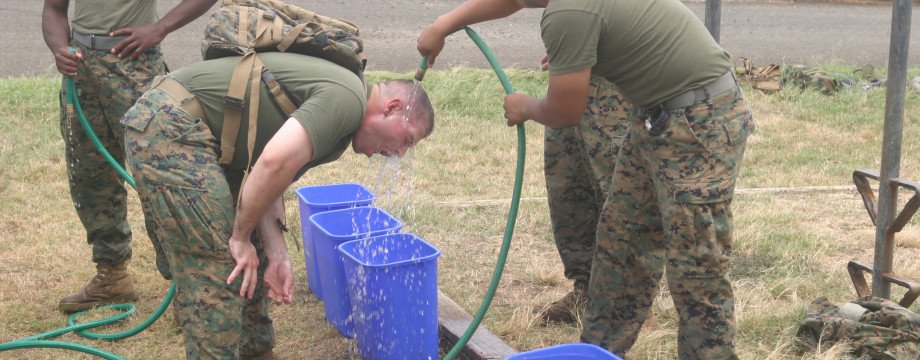
Lt. Mike Mckenna, India Comapny. Marine Corps Base Hawaii. July 2005.
“India Company conducted Marine Security Element (MSE) Pre-Assumption week two training to include: Non-lethal weapons classes and Oleoresin Capsicum (OC) Qualification.” — Source: 3/3 Command Chronology for the Period 01 July to 31 December 2005
Contents
News
India Company, 3/3 endures Oleoresin Capsicum spray
India Company conducted Marine Security Element (MSE) Pre-Assumption week two training to include: Non-lethal weapons classes and Oleoresin Capsicum (OC) Qualification.
MARINE CORPS BASE HAWAII, KANEOHE BAY, Hawaii — “I just want to get it over with,” said Lance Cpl. William S. Bolamos, fire-team leader, India Company, 3rd Battalion, 3rd Marine Regiment, as he stood in line to get his share of Oleoresin Capsicum spray squirted into his eyes, July 28, during an O.C. spray course held at the Boondocker aboard Marine Corps Base Hawaii, Kaneohe Bay. “I’m totally relaxed now, but I know as soon as it’s my turn to be sprayed, the nervousness will hit me.”
This was the first time Bolamos, a Miami, Fla. native, had been sprayed with the O.C. spray, which was the same situation for more than 90 percent of his fellow Marines from India Company. The armed services have been using O.C. spray since 1993 for riot control by their military police. Under the guidelines set forth in ALMAR 305-98, Marines required to carry the spray will experience the effects of O.C. with a level-one exposure, which is direct contamination.
“Our Marines are now assuming the Marine Security Element for Joint Task Force 510, based out of Marine Forces Pacific, Camp Smith,” said Lt. Justin M. Bellman, executive officer, India Company, 3/3. “We’re going through the O.C. spray course so we know the techniques in case we have to react to a riot or a nonlethal situation.”
Bellman, a Newark, Del. native, described the nonlethal weapon, which is the oil taken from the placenta near the stem of a pepper, they are being sprayed by, to be 10 times more effective than the average pepper spray purchased from stores.
“This spray we’re using causes temporary blindness, loss of balance and contains a small amount of gas that makes it hard to breath,” said Bellman. “The whole reason for the Marines going through this course is so they can overcome and react to punching and anything else they may encounter in a riot situation.”
Bellman said he thought that the training was very effective and the techniques the Marines learned would be very useful if the time ever came for them to be applied.
“If these Marines can take a hit of O.C. and finish the course, then they’re good to go,” said Bellman. “We hope the time never comes where these techniques are needed, but it’s better to be safe than sorry.”
Each Marine who finished the course received a certificate of completion and was designated O.C. certified. The certificate acknowledges that they have met all of the requirements of the course.
“The worst part about the course was getting sprayed, obviously,” said Lance Cpl. Charles J. Edwards, police sergeant, Lima Company, 3/3. “It didn’t burn too bad until I got to the second station where they were hitting me with the bags.”
Edwards described the sensation as feeling like the devil was burning his face with fire.
“I was nervous, but I had an idea of what it was going to feel like, because I have been sprayed with regular pepper spray before,” said Edwards. “Once it happened I thought my face was one fire. I didn’t think anything could be that hot.”
The O.C. spray, although painful, is not life threatening and has been found to play an important role within the riot control and MP communities, as well as units deployed in peace-keeping missions around the world.
Source: Marine Corps Base Hawaii
Photographs
- Lance Cpl. Nathan T. Becklo, India Comapny. Marine Corps Base Hawaii. July 2005.
- Lt. Mike Mckenna, India Comapny. Marine Corps Base Hawaii. July 2005.


